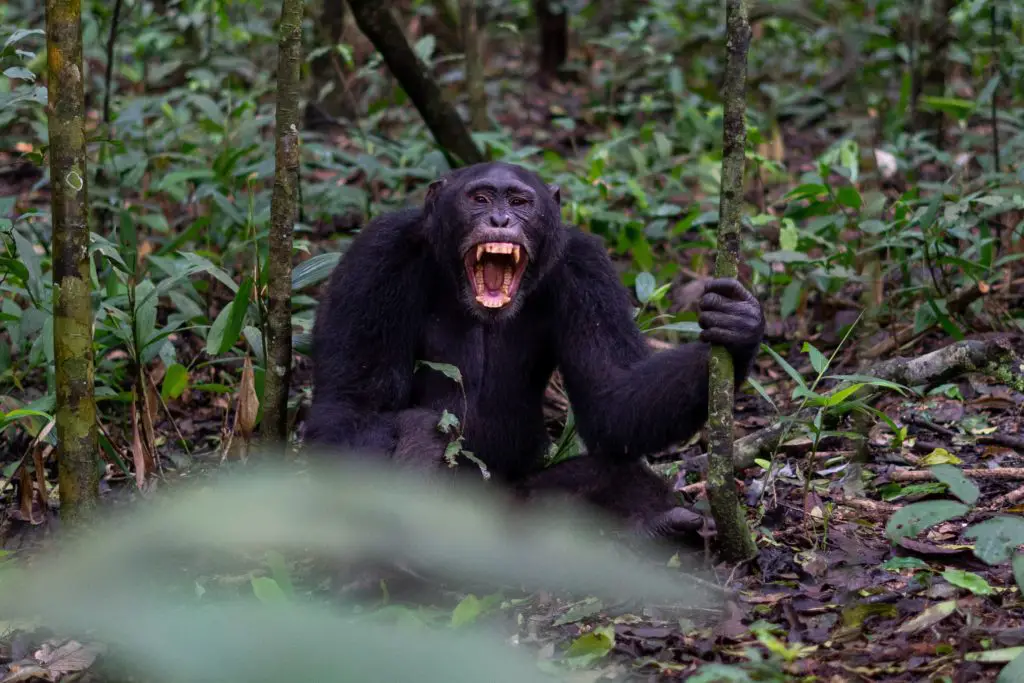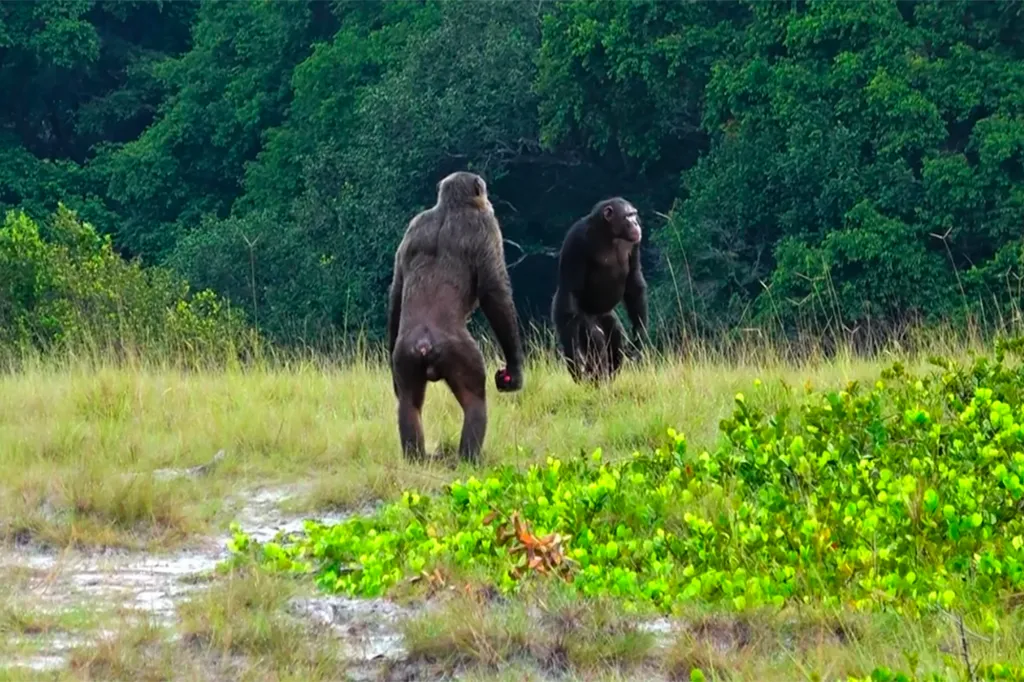Chimpanzees have recently been observed killing gorillas in unprovoked attacks, a behavior that is unprecedented, according to a study published in the journal Nature. These incidents took place at Loango National Park in Gabon and marked the first documented cases of such lethal encounters between the two species. While both chimpanzees and gorillas can exhibit territorial and aggressive behaviors, they have historically kept their fights limited to within their own species. This new behavior raises questions about the factors that may be triggering these violent interactions.
Chimpanzees Killing Gorillas: Unprovoked Attacks Unearthed

In December 2019, a group of more than two dozen chimps targeted five gorillas at the national park. Initially, the researchers thought they were observing a typical encounter between neighboring chimpanzee communities, as they heard only chimpanzee screams. However, they soon realized that the encounter involved gorillas, as they heard chest beats characteristic of these larger primates. Although the adult gorillas managed to escape, an infant gorilla, separated from its mother, did not survive the attack.
The unprecedented nature of these attacks has left scientists intrigued and baffled. Chimpanzees and gorillas are closely related genetically, sharing a common ancestor that lived millions of years ago. Given their shared ancestry, researchers have long assumed that these two species would have a certain level of tolerance and peaceful coexistence. These recent incidents challenge that assumption and force us to reconsider our understanding of their interactions.
In February 2019, another attack occurred, resulting in the death of another infant gorilla. Strikingly, during this encounter, an adult female chimpanzee almost entirely consumed the infant gorilla. These cases of aggression between the two species are in stark contrast to their historical interactions that were typically peaceful, with instances of both species foraging harmoniously in the same trees. In some cases, playful interactions between chimpanzees and gorillas have even been observed.

Possible Triggers for Aggression
One avenue of exploration for scientists is the potential triggers for these sudden acts of aggression. Researchers are now delving deeper into the ecological and environmental factors that might be contributing to these violent encounters. Climate change, and food scarcity could all play a role in pushing chimpanzees and gorillas to the brink, potentially leading to territorial disputes and conflicts over limited resources.
Climate change has been altering the landscape and availability of resources in many natural habitats, including the forests of Gabon. As temperatures rise and rainfall patterns shift, the distribution of food sources for these primates may be affected. This could result in increased competition for dwindling resources, potentially escalating tensions between chimpanzees and gorillas.
Exploring Unprecedented Aggression: Chimpanzee-Gorilla Interactions in Primatology
In the world of primatology, the interactions between chimpanzees and gorillas have long been a subject of fascination. The recent violent encounters between these two species have left researchers and experts puzzled. Dr. Simone Pika, a cognitive biologist at Osnabrück University, expressed her surprise at the turn of events. She pointed out that prior observations had painted a picture of relatively relaxed interactions between chimpanzees and gorillas, with some even documenting moments of peaceful playfulness. These recent attacks, however, challenge the conventional wisdom of their previously harmonious coexistence.
One possible avenue for further investigation lies in the ecological and environmental changes occurring in the habitats shared by chimpanzees and gorillas. The increasing effects of deforestation and human intrusion have forced these primates to come into closer contact. This forced cohabitation in shrinking territories could be a significant stressor, leading to increased territorial disputes and competition for resources. To truly comprehend the motives behind these unprecedented acts of aggression, researchers may need to delve deeper into the changing dynamics of their shared ecosystems.
Intriguingly, there may be parallels between the aggressive encounters observed among chimpanzees and gorillas and the societal tensions seen in human communities. Ethologists have long drawn connections between primate behavior and human social structures. Understanding these parallels could shed light on not only the immediate triggers for these conflicts but also the deeper social dynamics at play. This comparative approach to studying primate behavior may offer valuable insights into our own species’ behavior and cooperation, or lack thereof.

As technology advances, researchers are also increasingly relying on innovative tools and methodologies to gain a more comprehensive understanding of primate behavior. For instance, the use of drones and camera traps has allowed scientists to observe these animals in their natural habitats without directly intruding on their space. These non-invasive techniques offer a unique perspective on the interactions between chimpanzees and gorillas, capturing moments that would have otherwise gone unnoticed.
Furthermore, it is crucial to consider the potential implications of these aggressive encounters on the conservation efforts for both chimpanzees and gorillas. Both species are already endangered, facing threats such as habitat destruction, poaching, and disease. The newfound aggression between them adds another layer of complexity to their survival. Conservationists must adapt their strategies to address the changing dynamics and mitigate the risks associated with these conflicts. Understanding the motivations behind the aggression can inform more targeted conservation efforts, ensuring the long-term survival of these magnificent creatures.

The Alarming Decline: Chimpanzee and Gorilla Populations on the Brink
Statistics show that the populations of both chimpanzees and gorillas have been dwindling over the years. In 2020, the International Union for Conservation of Nature (IUCN) updated the status of the Eastern gorilla to “Critically Endangered,” the highest level of threat. Chimpanzees, too, face a grim future, with the IUCN listing them as “Endangered.” These statistics emphasize the urgency of addressing the challenges faced by these species and the need for a holistic approach to conservation.
One aspect worth investigating is the role of individual personalities within chimpanzee and gorilla groups. Just as humans have a range of personalities, it’s increasingly recognized that primates also exhibit diverse character traits. Some individuals may be more prone to aggression, while others are more inclined towards cooperation. Understanding the interplay of these personalities within primate communities can provide valuable insights into the dynamics that lead to aggression. It could help identify potential mitigating factors, such as the influence of dominant individuals or the role of social bonds in diffusing tensions.
Recent research has also explored the impact of social learning and cultural transmission among chimpanzee and gorilla groups. These primates have demonstrated the ability to learn from one another and pass on behaviors and traditions through generations. Investigating whether the recent spate of aggression has any cultural component is a promising avenue for future study. It could reveal whether these aggressive behaviors are learned and perpetuated within specific communities, shedding light on the underlying causes.
In light of the unprecedented violence witnessed among chimpanzees and gorillas, there is a growing need for collaborative efforts among primatologists, conservationists, and local communities. Conservation initiatives often involve close cooperation with local residents living near primate habitats. Engaging these communities and garnering their support is essential for the success of conservation efforts. Furthermore, raising awareness about the challenges these primates face and the importance of their conservation is vital to building a global commitment to protecting these remarkable creatures.

This Site Was Inspired By An Interest in Protecting the Environment:
We had the privilege and joy of learning from Dr. Charlie Stine who instilled a love for the natural world through incredible field trips with the Johns Hopkins Odyssey Certificate program in Environmental Studies. At the time, the program was endorsed by the Maryland Department of Natural Resources. Sadly, after Dr. Stine retired, the program was phased out. We hope that we honor his legacy by shining a bright light on environmental issues and sharing good news about the success of various conservation programs when possible.

